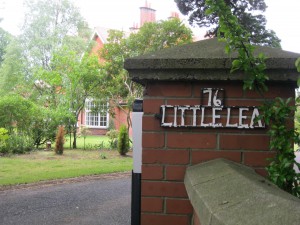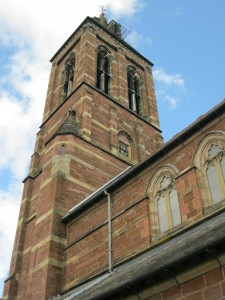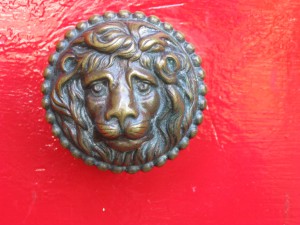Week Seven of the C.S. Lewis and Women Series
Joy Davidman (Lewis)
![250px-Joy_Davidman.[1]](http://crystalhurd.com/wp-content/uploads/2013/07/250px-Joy_Davidman.11-214x300.jpg)
Photo courtesy of en.wikipedia.org
For a good wife contains so many persons in herself. What was [Joy] not to me? She was my daughter and my mother, my pupil and my teacher, my subject and my sovereign; and always, holding all these in solution, my trusty comrade, friend, shipmate, fellow-soldier. My mistress; but at the same time all that any man friend (and I have good ones) has ever been to me…There is, hidden or flaunted, a sword between the sexes till an entire marriage reconciles them. It is arrogance in us to call frankness, fairness, and chivalry ‘masculine’ when we see them in a woman; it is arrogance in them to describe a man’s sensitiveness or tact or tenderness as ‘feminine.’ But also what poor warped fragments of humanity most mere men and mere women must be to make the implications of that arrogance plausible. Marriage heals this. Jointly the two become fully human. ‘In the image of God created He them. Thus, by a paradox, this carnival of sexuality leads us out beyond our sexes. – 455-456 A Grief Observed
In 1950, a poet from New York added her name to a long roster of Lewis’s female correspondents. She was a recent convert, a former Communist, who had come to Christ through personal revelations assisted by works of Lewis and his Inkling friend Charles Williams. Helen Joy Davidman (called “Joy”) had travelled a long, laborious, and labyrinthine journey to arrive on the margins of Christianity. Like Lewis, Joy professed atheism after straying from her Jewish roots. She, like Lewis, paused and considered the intellectual implications of faith early in her journey.
As Lyle Dorsett writes in his work chronicling Joy’s life, And God Came In, Joy came of age in the heterogeneous turbulence of New York City in the 1920s. Her mother Jeanette descended from affluent Jewish merchants who had abandoned their home in the Ukraine , migrating like thousands of others to the “promised land” of America. Jeanette, essentially, was historically Jewish. However, her husband Joseph Davidman was an atheist who restrained his untraditional views to ensure peace in his household; Dorsett identifies it as a “tepid indifference” to Judaism. As educators and voracious readers, Joy’s parents fostered an appetite for knowledge into Joy and her younger brother Howard. During the summer, it was not uncommon for Joy and Howard to visit the library nearly every day, although her parents maintained an impressive library in their home.
However, Joy’s early life was extremely difficult. Her father was cantankerous and overbearing. Some family members recall Joseph blowing a whistle to summon his children “in the fashion of trained dogs”. Joy, forever the doting daughter, attempted to win her father’s affection. A bright, receptive student, Joy excelled in academics. Although she suffered from a crooked spine, Graves Disease and hyperthyroidism, which contributed to excessive school absences, her grades were largely unaffected. She was soon recognized as a poet with the publication of her poem “Resurrection” (a poem shaped by religious themes, although Joy described it as a “private argument with Jesus”). In addition to a demanding father and nagging illnesses, Joy and her brother Howard endured the “demons of anti-Semitism” which plagued them nearly everywhere they went, even when they travelled throughout the United States on holidays and vacations.
Joy eventually matriculated to Hunter’s College, a tuition-free women’s college located in the Bronx. Joy thrived there; she quickly found her youthful love of books had matured into an abiding love of literature and language. Joy was already “proficient” in German and Latin, learned French in college, and taught herself Greek in her spare time. She also began crucial friendships with other students of the literary persuasion, including novelist Bel Kaufman. While at Hunter’s, Joy served as associate editor of the literary magazine Echo while participating in the English club and Sigma Tau Delta,the national English studies honorary society. Joy published a story in Echo titled “Apostate” in which a young Jewish woman elopes with a Christian to avoid an arranged marriage to a “weak man”. The woman is baptized into the Christian faith so she may wed, but the wedding is disrupted by her family who violently beat her as her “husband” looks on and the pastor escapes. The story won the Bernard Cohen Short Story Prize that year. After graduation, she obtained employment as an English teacher at Walton High School. She also decided to pursue a Master’s degree in English at Columbia University.
![joy-davidman-gresham-lewis[1]](http://crystalhurd.com/wp-content/uploads/2013/07/joy-davidman-gresham-lewis1-221x300.jpg)
Photo courtesy of cslewis.drzeus.net
Her towering academic achievements were unfortunately overshadowed by major cultural shifts. The Great Depression ravaged the overcrowded, unemployed residents of New York. Some predicted a slow, yet steady pace of national rehabilitation, but the hopelessness, for some, was too much to bear. One afternoon before her graduation in 1934, Joy watched in horror as a young woman on an adjoining building plunged to her death. The girl had leapt to her demise after struggling unsuccessfully with depression and hunger. Joy interpreted this as a byproduct of the growing capitalistic society upon which many staked the precarious recovery of the American economy. Although Joy had never experienced the pangs of hunger and poverty, she felt a deep compassion stirring for those less fortunate: “…her anger grew increasingly at the insanity and callousness of a society that dumped potatoes in the ocean, burned wheat, and poured lime on oranges, while millions of people were unemployed, malnourished, and forced to stand in soup lines and sort through refuse in garbage cans for sustenance” (Dorsett 21). These images, coupled with her increasing animosity toward greedy corporations, eventually led Joy to join the Communist party.
Joy resigned from her teaching position in 1937 to devote more time to writing. Earlier, in 1936, some of Joy’s poems were published in Poetry magazine. This connection would eventually lead her to a friendship with celebrated novelist and poet Stephen Vincent Benet. Benet headed the Younger Poet Series for Yale University Press. When Joy submitted nearly fifty poems for the competition, she won a quick admirer in Benet. These works were published by Yale University Press as Letters to a Comrade in 1938. During this time, at the behest of Benet, Joy spent time at the MacDowell Colony in Peterborough, New Hampshire. This colony utilized the concept of collaboration and encouragement among writers and artists to produce and refine good art. It served as an artistic catalyst as well as a retreat from the tumultuous society surrounding them. Much like the Romantics of the nineteenth century, repose and restoration through nature were viewed as anodynes for the treacherous stranglehold of modern life. Former members of MacDowell include author Willa Cather and poet Sara Teasdale. If writers and artists were chosen for the colony, they were expected to pay their own expenses, although impoverished ones could still attend with the assistance of philanthropic donations provided by wealthy businessmen and politicians such as Andrew Carnegie, J.P. Morgan and President Grover Cleveland. Ironically, Joy used her time at MacDowell to rail against the evils of capitalism (although she was not a sworn Communist yet) while some of her associates attended only through the sponsorship of corporations! MacDowell Colony proved to be artistically beneficial for Joy. She published a novel, Anya, in 1938.
Joy soon became a sworn communist and spent much creative energy contributing to the communist publication New Masses; she also worked a stint in Hollywood writing scripts. Joy eventually met and married fellow writer William Lindsay Gresham.
![william-lindsay-gresham[1]](http://crystalhurd.com/wp-content/uploads/2013/07/william-lindsay-gresham1.jpg)
William (Bill) Lindsay Gresham
Photo courtesy of www.thewaythefutureblogs.com
The couple lived in utter poverty, struggling to make ends meet through their literary endeavors. Joy had two sons, but William’s alcoholism and unfaithfulness were wearing on Joy. With no coping mechanism for the increasing strain on his family and finances, Bill Gresham began to spiral out of control. One fateful night, Bill called Joy exclaiming that he was having a “nervous breakdown”. He “couldn’t stay where he was” but “couldn’t bring himself to come home”. Then he hung up the phone. Joy was frantic. She calmly put her boys to bed, then spent the evening on the phone attempting to locate Bill to no avail. She writes in her essay “The Longest Way Round”:
By nightfall there was nothing left to do but wait and see if he turned up, alive or dead. I put the babies to sleep and waited. For the first time in my life I felt helpless; for the first time my pride was forced to admit that I was not, after all, “the master of my own fate” and “the captain of my soul”. All my defenses – the walls of arrogance and cocksureness and self-love behind which I hid from God – went down momentarily. And God came in. – From Out of My Bone: The Letters of Joy Davidman (Ed. Don W. King).
Joy writes that she felt “a Person” in the room with her that night. She also admits that, a year or so prior to this occurrence, she had begun reading fantasy works which had led her to C.S. Lewis; Joy specifically cites The Screwtape Letters, Miracles, and The Great Divorce as particularly influential. These works provided Joy not only with entertainment, but with intellectual stimulation in a curious, new direction – the rational argument for faith, a faith she had previously dismissed and eschewed. That night, overwhelmed by the lack of control over her family life, Joy felt the philosophical foundation shifting beneath her feet. The fortifications of her atheism were collapsing, and the origin of her wanderlust was being revealed to her. The towering presence of Truth was educating her at this moment. She could no longer deny that God didn’t exist. After several days, William returned home and found a new woman. Joy renounced atheism and began attending church. She indulged her interests in religious philosophy and Christian dogma, seeing it not as a complicated enigma teeming with restrictions and empty litanies uttered to concrete gods, but as an unnamed pulse of life surging through mankind offering liberation and a renewed appreciation for beauty. She befriended professor Chad Walsh, who maintained a robust correspondence with none other than C.S. Lewis. Fascinated and grateful to Lewis, Joy began a correspondence with him in 1950. Joy mentions in “The Longest Way Round”: “I went back to C.S. Lewis and learned from him, slowly, how I had gone wrong. Without his works, I wonder if I and many others might not still be infants “crying in the night'” (95). The experience influenced her next novel, Weeping Bay. Although Joy was ecstatic over the spiritual changes occurring within her, it did little to repair her marriage. William was still drinking and began to dapple in Buddhism while Joy was exploring and practicing orthodox Christianity. In August 1952, she sailed to England “to consult one of the clearest thinkers of our time for help”. She stayed with a friend, Phyllis Williams, while in London and arranged to meet Lewis in Oxford at the Eastgate Hotel. The visit was a rousing good time. George Sayer recalls this meeting in his biography Jack: A Life of C.S. Lewis:
The party was a decided success. Joy was of medium height, with a good figure, dark hair, and rather sharp features. She was an amusingly abrasive New Yorker, and Jack was delighted by her bluntness and her anti-American views. Everything she saw in England seemed to her far better than what she had left behind. Thus, of the single glass of sherry we had before the meal, she said: ‘I call this civilized. In the States, they give you so much hard stuff that you start the meal drunk and end with a hangover.’ She was anti-urban and talked vividly about the inhumanity of the skyscraper and of the new technology and of life in New York City…She attacked modern American Literature…’Mind you, I wrote that sort of bunk myself when I was young..’ Small farm life was the only good life, she said. Jack spoke up then, saying that, on his father’s wise, he came from farming stock. “I felt that,’ she said. ‘Where else could you get the vitality?’
Joy made quite an impression on the bachelor don. He invited Joy to dine with him at Magdalen College along with his brother Warnie, who had been absent during the initial meeting at the Eastgate Hotel. Warnie loved Joy – her quick wit, her boundless sense of humor, her keen intellect. Joy returned to stay at The Kilns during Christmas. The Lewis men immensely enjoyed Joy’s visit. Joy and Lewis discuss her upcoming book Smoke on the Mountain. That Christmas, Lewis gave Joy a copy of George MacDonald’s Diary of an Old Soul with an initial inscription from George MacDonald, followed by “Later: from C.S. Lewis to Joy Davidman, Christmas 1952”.** Joy had a rapturous time at The Kilns, but the tone changed significantly when a letter arrived from Bill. Joy’s cousin Renee was looking after her sons during her voyage and English holiday. Bill admitted that he had fallen in love with Renee and recommended that he and Joy file for divorce. Distressed and confused, Joy asked Lewis for guidance; Lewis ultimately agreed with Bill and suggested a divorce.
![cs-lewis-with-stepsons-david-and-douglas[1]](http://crystalhurd.com/wp-content/uploads/2013/07/cs-lewis-with-stepsons-david-and-douglas1-219x300.jpg)
Lewis with David and Douglas Gresham – 1957
Photo courtesy of adventuresofabeautyqueen.com
In late November, Joy moved, with her sons in tow, to England. Her marriage was dissolving but Joy was happy to be “a transplant”. She struggled to provide for her family, as Bill’s child support checks were insufficient and often unpredictable. She maintained her friendship with Lewis, even later obtaining a residence in Headington, near The Kilns. Lewis would visit “every day” with many visits lasting “until eleven at night”. Although many maintain that Joy “forced herself” on Lewis because she needed financial assistance, these visits were prompted by Lewis, not by Joy. In the summer of 1955, Chad and Eva Walsh visited Lewis and Joy and “smelled marriage in the air”. However, Lewis endorsed the Church of England edict which claims that marriages are holy unions and cannot be dissolved, and thus remarriage was impossible.
Nonetheless, Lewis eventually fell in love with Joy. Some of his friends disapproved of the union, partially because of the Church’s views concerning divorce and partly because Joy was known to have an explosive temper. George Sayer recalls one afternoon during which he had business in town and left his wife Moira to read at The Kilns until he was finished. Lewis excused himself to take a nap and when Joy returned with Lewis’s laundry to find a woman at The Kilns, she was infuriated: “Who the hell are you and what the bloody hell are you doing in this house?” Moira had previously met Joy and attempted to unsuccessfully jog Joy’s memory, ‘We have met before and I have been invited here by Mr. Lewis”. Livid, Joy stamped out.
![surprised_by_joy[1]](http://crystalhurd.com/wp-content/uploads/2013/07/surprised_by_joy1.jpg)
Photo courtesy of thoughtsonbookss.blogspot.com
Despite her temper, it was obvious that Joy was passionately in love and that Lewis was developing mutual feelings for Joy. Although I am not at liberty to discuss them, I read all of Joy’s now famous and controversial love sonnets while conducting research at the Wade Center in Wheaton, Illinois last month. These sonnets were most likely written in 1953, during her initial visit to England. If you would like more information on these sonnets, please read Don W. King’s recent article “A Naked Tree: Joy Davidman’s Love Sonnets to C.S. Lewis” in the latest edition of SEVEN, published by the Marion E. Wade Center. In this article, King summarizes the sonnets and provides excellent literary analysis on their origin and meaning. Comically, Lewis at first puts Joy off by claiming that he prefers blondes. Perhaps it was the humor of an old bachelor, but Joy is deeply affected by this dismissal. The theme emerges in several of the sonnets.
As many now know, thanks to the romantic yet hyperbolic film Shadowlands, Joy’s residential permit was not renewed by the British Home Office. To extend his British citizenship, Lewis generously married Joy in a civil ceremony on 23 April 1956. Lewis kept the affair quiet, fearing criticism and disapproval from his colleagues and friends. Joy was then diagnosed with cancer (originating from radium treatments for her thyroid condition when she was young). She began evasive cancer treatments. The illness proved to be a turning point for Lewis; he realized that he truly did love Joy. Furthermore, he wanted to seal a commitment before God. In the spring of 1957, Lewis’s friend, the Reverend Peter W. Bide, arrived at the hospital to pray for Joy’s recovery. Bide eventually agreed to marry the couple, and did so on 21 March 1957. After this, Joy experienced a period of brief but wonderful convalescence. They honeymooned in Wales and Ireland. Later they spent twelve glorious days in Greece with the Greens (Roger and June).
But unfortunately the shadow of cancer returned. Joy was in a wheelchair, but still gregarious and lively, playing Scrabble and chatting frequently with Lewis. Despite all of the optimism, all knew, including Joy herself, that the time was at hand.
![thumb_0399e29dfb[1]](http://crystalhurd.com/wp-content/uploads/2013/07/thumb_0399e29dfb1-300x263.jpg)
Photo courtesy of www.awesomestories.com
Joy passed away on 13 July 1960. Although their marriage had been brief, it was an experience which made Lewis incandescently happy. The loss shook him to his very core. His reflections on Joy’s death were later published as A Grief Observed.
The Controversy of Joy
In many academic circles, Joy is portrayed as a sassy, impertinent shrew who exploited a kind, overly generous bachelor for citizenship, tuition for her children, a home, and eventually two marriages. Many prominent scholars have chosen to diminish, if not altogether ignore, Joy’s contribution to Lewis’s bibliography (Til We Have Faces is dedicated to her – Lewis believed it was his best work) as well as her personal/emotional impact on Lewis. It is perplexing that so many scholars dismiss Joy’s influence because they felt she intruded on Lewis’s good nature. The love sonnets reveal that she was passionately in love with Lewis. Initially, it was an intellectual attraction which matured into a sexual one. They shared many aspects of their interests and their faith, including a similar conversion experience (Joy and Lewis admit to being “on their knees” in search of God), the mutual love of language, a thirst for knowledge and truth, and the strong desire to serve God with their literary talents.
Joy thoroughly loved Lewis as Lewis thoroughly loved Joy. She truly made him happy. One cannot simply erase her from Lewis’s narrative simply because she seemed abrasive. Many of Lewis’s friends did not agree with his marriage, but in the end, Lewis enjoyed a wonderful love affair with his wife, who provided creative collaboration, served as an artistic influence, and showed him a love which surpassed his already vivid imagination. A Grief Observed was not written for Lewis’s mother or Mrs. Moore – it was an outstanding record of Lewis’s deep, undying love for his wife, whom he refers to throughout as his “lover”. The love sonnets reveal that Joy fostered this same love for Lewis much earlier, but the feelings expressed were no less substantial.
Consider these passages from A Grief Observed:
The most precious gift that marriage gave me was this constant impact of something very close and intimate yet all the time unmistakably other, resistant – in a word, real. Is all that work to be undone? Is what I shall still call [Joy] to sink back horribly into being not much more than one of my old bachelor pipedreams? Oh my dear, my dear, come back for one moment and drive that miserable phantom away. Oh God, God, why did you take such trouble to force this creature out of its shell if it is now doomed to crawl back – to be sucked back – into it? (447)
You tell me, ‘she goes on.’ But my heart and body are crying out, come back, come back. Be a circle, touching my circle on the plane of Nature. But I know this is impossible. (449).
This, to me, is resonant of Song of Solomon, chapter three:
On my bed by night
I sought him whom my soul loves;
I sought him, but found him not.
I will rise now and go about the city,
in the streets and in the squares;
I will seek him whom my soul loves.
I sought him, but found him not.
The watchmen found me
as they went about in the city.
“Have you seen him whom my soul loves?”
In the Biblical account of the bride’s dream, she eventually discovers “the one whom her soul loves”. But Lewis realizes that he will not, in this life, encounter Joy again.
Lord, are these your real terms? Can I meet [Joy] again only if I learn to love you so much that I don’t care whether I meet her or not? Consider, Lord, how it looks to us. What would anyone think of me if I said to the boys, ‘No toffee now. But when you’ve grown up and don’t really want toffee you shall have as much of it as you choose? If I knew that to be eternally divided from [Joy] and eternally forgotten by her would add greater joy and splendor to her being, of course I’d say, ‘Fire Ahead.’ Just as if, on earth, I could have cured her cancer by never seeing her again. I’d have had to. (460)
In the conclusion, Lewis writes,
How wicked it would be, if we could, to call the dead back! She said not to me but to the chaplain, ‘I am at peace with God.’ She smiled, but not at me. Poi is torno all’ eternal fonta [Then unto the eternal fountain she turned].
For Joy’s epithet, Lewis wrote,
Here the whole world (stars, water, air,
And field, and forest, as they were
Reflected in a single mind)
Like cast off clothes was left behind
In ashes, yet with hopes that she,
Re-born from holy poverty,
In lenten lands, hereafter may
Resume them on her Easter Day
Lewis describes her as “the whole world…Reflected in a single mind”. What beautiful and poignant words devoted to a fascinating woman. Yes, Joy Lewis was flawed, as we all are. But to tarnish her legacy with misconception and doubts, to excuse her contributions as manufactured chivalry extended by a benevolent bachelor to a lonely and divorced mother, to characterize her as a “gold digger”, is simply inaccurate. As researchers, we exhaustively explore to uncover the truth. After reading the love sonnets, my humble impression is that Joy Davidman adored C.S. Lewis. She loved him as deeply and as wholeheartedly as a woman can love a man, no matter how coy and resistant he was. As illustrated in the opening quote, Lewis reciprocated these passionate feelings. She was his helpmate, his lover, his wife. And the evidence strongly suggests that she was proud and grateful to be called “Mrs. Lewis”.
Joy, I argue, will also help Lewis shape and more sharply define his female characters. She radically alters his feminine preconceptions and ultimately his portrayals of women. Next week, we will begin our literary analysis of these characters with his first fictional work A Pilgrim’s Regress. Join me!
**I actually held this exact copy on my visit to the Wade Center last month, where many Lewis possessions are currently stored. Some furniture, such as Lewis’s desk and wardrobe, are on display for visitors, scholars, and enthusiasts – http://www.wheaton.edu/wadecenter.
![image[1]](http://crystalhurd.com/wp-content/uploads/2014/01/image1-300x54.png)
![1488262_489801321140918_172966278_n-600x222[1]](http://crystalhurd.com/wp-content/uploads/2014/01/1488262_489801321140918_172966278_n-600x2221-300x111.jpg)
![New-year-2014-Free-Wallpaper[1]](http://crystalhurd.com/wp-content/uploads/2014/01/New-year-2014-Free-Wallpaper1-300x225.jpg)
![304401_4071249774345_1467545579_n[1]](http://crystalhurd.com/wp-content/uploads/2014/01/304401_4071249774345_1467545579_n1-300x199.jpg)
![Malcolm Signing[1]](http://crystalhurd.com/wp-content/uploads/2014/01/Malcolm-Signing1-225x300.jpg)
![17608_10201764539225332_1323886110_n[1]](http://crystalhurd.com/wp-content/uploads/2014/01/17608_10201764539225332_1323886110_n11-300x225.jpg)
![Booked-book-launch-e1360288441534[1]](http://crystalhurd.com/wp-content/uploads/2014/01/Booked-book-launch-e13602884415341-300x199.jpg)
![1239804_10202284842752595_2107153711_n[1]](http://crystalhurd.com/wp-content/uploads/2014/01/1239804_10202284842752595_2107153711_n1-300x217.jpg)
![1526143_10203087516658941_8146718_n[1]](http://crystalhurd.com/wp-content/uploads/2014/01/1526143_10203087516658941_8146718_n1-300x225.jpg)
![971520_10201732806112024_346527085_n[1]](http://crystalhurd.com/wp-content/uploads/2014/01/971520_10201732806112024_346527085_n1-300x275.jpg)
![250px-Joy_Davidman.[1]](http://crystalhurd.com/wp-content/uploads/2013/07/250px-Joy_Davidman.11-214x300.jpg)
![joy-davidman-gresham-lewis[1]](http://crystalhurd.com/wp-content/uploads/2013/07/joy-davidman-gresham-lewis1-221x300.jpg)
![william-lindsay-gresham[1]](http://crystalhurd.com/wp-content/uploads/2013/07/william-lindsay-gresham1.jpg)
![cs-lewis-with-stepsons-david-and-douglas[1]](http://crystalhurd.com/wp-content/uploads/2013/07/cs-lewis-with-stepsons-david-and-douglas1-219x300.jpg)
![surprised_by_joy[1]](http://crystalhurd.com/wp-content/uploads/2013/07/surprised_by_joy1.jpg)
![thumb_0399e29dfb[1]](http://crystalhurd.com/wp-content/uploads/2013/07/thumb_0399e29dfb1-300x263.jpg)
![1320_pitterlarge2[1]](http://crystalhurd.com/wp-content/uploads/2013/07/1320_pitterlarge21.jpg)
![King_D2-mr[1]](http://crystalhurd.com/wp-content/uploads/2013/07/King_D2-mr1-188x300.jpg)
![ruth-pitter-154x209[1]](http://crystalhurd.com/wp-content/uploads/2013/07/ruth-pitter-154x2091.jpg)
![Anscombe3[1]](http://crystalhurd.com/wp-content/uploads/2013/06/Anscombe311.jpg)
![Sister Penelope[1]](http://crystalhurd.com/wp-content/uploads/2013/06/Sister-Penelope1-223x300.jpg)
![Sister Penelope[1]](http://crystalhurd.com/wp-content/uploads/2013/06/Sister-Penelope12-223x300.jpg)
![ruth-pitter[1]](http://crystalhurd.com/wp-content/uploads/2013/06/ruth-pitter1.jpg)
![url-2[1]](http://crystalhurd.com/wp-content/uploads/2013/06/url-21.jpeg)
![dorothy_l_sayers_1928[1]](http://crystalhurd.com/wp-content/uploads/2013/06/dorothy_l_sayers_19281.jpg)
![janie-king-moore[1]](http://crystalhurd.com/wp-content/uploads/2013/06/janie-king-moore11.jpg)
![thumb_3e564d1426[1]](http://crystalhurd.com/wp-content/uploads/2013/06/thumb_3e564d14261-300x218.jpg)
![lewis_mrsmoore[1]](http://crystalhurd.com/wp-content/uploads/2013/06/lewis_mrsmoore1.jpg)
![jack-maureen-mrsmoore[1]](http://crystalhurd.com/wp-content/uploads/2013/06/jack-maureen-mrsmoore1-300x182.jpg)
![albert-lewis2[1]](http://crystalhurd.com/wp-content/uploads/2013/06/albert-lewis21-205x300.jpg)
![cherbourg_house[1]](http://crystalhurd.com/wp-content/uploads/2013/06/cherbourg_house1.jpg)
![flora-augusta[1]](http://crystalhurd.com/wp-content/uploads/2013/05/flora-augusta1-221x300.jpg)




![IMG_3490a-M[1]](http://crystalhurd.com/wp-content/uploads/2013/05/IMG_3490a-M11-300x200.jpg)